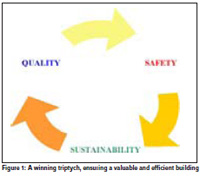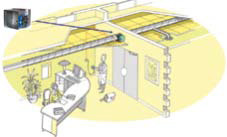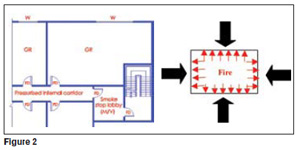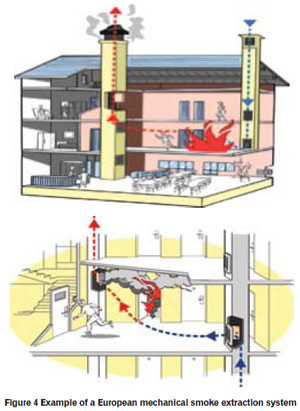Fires cause loss of life, damage property and harm the environment. HVAC fire protection issues inside buildings are, therefore, important. Now, thanks to a positive fire code and a regulatory framework in place, the UAE is better prepared to combat the menace, writes Alexandre Benoit.
Fires cause loss of life, damage property and harm the environment. HVAC fire protection issues inside buildings are, therefore, important. Now, thanks to a positive fire code and a regulatory framework in place, the UAE is better prepared to combat the menace, writes Alexandre Benoit.
Fires in the UAE
 Fire hazards within buildings are still a global concern, especially in the UAE, where more than 2,000 fires occur annually. The fires are caused essentially by accidental human factors (60%) and technical failures (40%). They result in deaths, injuries and/or damages, which form a threat to residents and tourists in the UAE. For this reason, preventive safety against fire hazards and disasters has become a major strategic objective in the Dubai Civil Defence Strategic Plan 2009-2015.
Fire hazards within buildings are still a global concern, especially in the UAE, where more than 2,000 fires occur annually. The fires are caused essentially by accidental human factors (60%) and technical failures (40%). They result in deaths, injuries and/or damages, which form a threat to residents and tourists in the UAE. For this reason, preventive safety against fire hazards and disasters has become a major strategic objective in the Dubai Civil Defence Strategic Plan 2009-2015.
Need for fire protection – preventive safety
Safety is a key subject that needs to be addressed, not only by the UAE authorities (civil defence), but also by developers, consultants and contractors, in order to ensure a maximum level of safety for all buildings presently under construction or already built.
 If sustainability can be considered as a positive trend taking shape slowly in the UAE to promote efficient green buildings (via effective water and waste management, energy consumption ratings and indoor environmental quality), quality and safety need to be further prioritised by the different construction bodies in the UAE. The quality and safety standards of building construction are still quite low in the UAE. This is due to various factors, such as cost reduction, lack of regulations, minimum specification requirements by consultants, poor labour skills, and disregard towards specifications by actual contractors. As a direct result, the UAE has faced structural collapses affecting some buildings or car parks under construction. But if these collapses constitute tangible and visible proof of bad quality of structural construction, a low level of quality and safety is also affecting the thermal insulation, the HVAC systems, and, indeed, the fire-protection systems, which are really critical, in the event of a fire.
If sustainability can be considered as a positive trend taking shape slowly in the UAE to promote efficient green buildings (via effective water and waste management, energy consumption ratings and indoor environmental quality), quality and safety need to be further prioritised by the different construction bodies in the UAE. The quality and safety standards of building construction are still quite low in the UAE. This is due to various factors, such as cost reduction, lack of regulations, minimum specification requirements by consultants, poor labour skills, and disregard towards specifications by actual contractors. As a direct result, the UAE has faced structural collapses affecting some buildings or car parks under construction. But if these collapses constitute tangible and visible proof of bad quality of structural construction, a low level of quality and safety is also affecting the thermal insulation, the HVAC systems, and, indeed, the fire-protection systems, which are really critical, in the event of a fire.
What actually is a fire?
Fire is the combination of flame and smoke caused by the combustion of gases occurring at high temperatures. The flame is the visible part of the fire which attacks and burns materials. Smoke is made of combustion gases. The resulting toxic and opaque fumes prevent people from breathing and affect the visibility required to escape a building. This creates panic. At high temperatures, the large volume of smoke generated by fire creates high pressures with convection movement. As a direct result of this, fire can spread quickly and unpredictably throughout the surrounding areas, if there is a lack of efficient compartmentation and if no smoke-management system is in place.

Alexandre Benoit
To effectively deal with the possible dangers caused by fire, the European Committee has developed different standards based on the following nomenclature for “the resistance to fire performance of construction products, construction works” (for example, fire dampers, smoke dampers and ventilation ducts in HVAC):
Victims – people, buildings and the environment
The first issue is that fire can pose a real danger for a country by endangering its people (family, children, people with disabilities, tourists and fire fighters), with deaths and injuries being often the result. As life is priceless, there should be no cost issues in bringing the best level of safety to a building. The key danger for people caught in a fire comes mainly from smoke inhalation, which can be managed efficiently through proper compartmentation of structural areas, plus an efficient smoke-management system.
The second issue resulting from a fire can be the destruction of a building or parts of a building, if effective compartmentalisation has not been implemented. The destruction implies a tangible cost for insurance companies, developers and even owners/tenants. This being the case, it is essential to limit the spread of flame, smoke and heat via efficient compartmentation, with “EIS” fire dampers, and to fight the fire with water (sprinkler systems) to notably reduce its intensity and spread.
 A fire can also cause damage to the environment, given the large amount of combustion gases emitted into the atmosphere during a blaze.
A fire can also cause damage to the environment, given the large amount of combustion gases emitted into the atmosphere during a blaze.
Impact on MEP/HVAC systems
There are four key priorities in protecting people, buildings and the environment during a fire:
Compartmentation:
 An efficient compartmentalisation is fundamental to ensure a minimum level of safety inside a building. The main objective is to subdivide a building into fire compartments to isolate a fire as soon as it starts and to limit the spread of flames, smoke and heat throughout the existing AC ductwork.
An efficient compartmentalisation is fundamental to ensure a minimum level of safety inside a building. The main objective is to subdivide a building into fire compartments to isolate a fire as soon as it starts and to limit the spread of flames, smoke and heat throughout the existing AC ductwork.
It’s critical that there be no smoke leakage and no heat transfer for two hours through any fire dampers. This means an efficient sealing system, for example, intumescent seal, use of sealant, and quality refractory blade material (for example, calcium silicate) should be in place. These fire dampers should be motorised to ensure instantaneous operation via a fire alarm panel connected to smoke detectors.
The key objective is to avoid any leakage of cold fumes through the blades of the fire damper, before the potential activation of a mandatory thermal trip or fusible link at 72°C. In the European EN 13501-3 classification, these fire dampers are classified EIS 120.
Moreover, to ensure energy savings and achieve a better sustainability, motorised fire dampers should be operated under an electric signal emission and not by a power cut.
Far too many curtain fire dampers (CFD) are still used in the UAE, even though their performance is really poor: smoke leakage through openings, heat transfer and late activation (only when the temperature reaches 72°C). The authorities, developers, consultants and even contractors should be more concerned about these issues, especially on large projects, such as the Masdar Institute of Sciences and Technology, where so much emphasis is placed on sustainability. Safety should come first. After all, a building on fire is not sustainable at all!
 Curtain fire dampers should be replaced by the more efficient fire dampers, described above, in new building, and especially in sensitive buildings – for example, high-rise buildings, hotels, schools, hospitals, which have occupancy, accompanied by potential sleeping risks.
Curtain fire dampers should be replaced by the more efficient fire dampers, described above, in new building, and especially in sensitive buildings – for example, high-rise buildings, hotels, schools, hospitals, which have occupancy, accompanied by potential sleeping risks.
Smoke-management systems:
The management of smoke is best done by controlling the high pressure of smoke generated directly by the fire. This allows people to escape safely via fire exits. The way smoke spreads is by moving from areas of high pressure to areas of lower pressure, in an attempt to find a balance. Consequently, there are two main ways to manage smoke:
1) Pressurisation:
The objective is to create a higher pressure in opposing areas – for example, staircases and corridors – of the fire compartment to avoid any smoke passageways, even if a door is opened (see figure 2).
2) Natural/mechanical smoke extraction – corridor smoke control):
The objective is to create a low pressure point in a corridor – opening through a smoke exhaust damper – to create a controlled smoke passageway. The goal is to extract the most smoke and combustion gases in the early stages of a fire in order to keep the escape and access routes free from smoke and gases (see figure 3).
The basic smoke extraction system is made by one vertical riser supplying outdoor air through an air inlet located close to the floor, and another vertical riser that extracts smoke via a smoke fan through a smoke exhaust damper located close to the ceiling. The goal is to create a smoke-free area (stratification) in the bottom area of a corridor to allow a safe escape, and to keep smoke in the upper area of the corridor before being discharged outside (see figure 4).
These two systems have two different strategies. Whereas the pressurisation system is fighting (with the support of a sprinkler system) against the high pressure of smoke generated by the fire, by creating a higher pressure, the advantage of the smoke-extraction system is to control the amount of smoke and heat not by fighting against it but rather by working together with its flow and leading the spread of smoke and heat towards safe exhaust openings.
This is a key advantage for a smoke-extraction system, considering that fire behaviour is nearly always unpredictable and uncontrollable. By supplying fresh air and exhausting smoke and heat close to the fire location, a smoke-extraction system reduces the danger for fire-fighters due to an under-ventilated fire (for example, flashover, backdraft). In turn, this dramatically eases the fire-fighters’ operations by reducing the temperature and increasing the visibility within the building.
Even if the burning rate increases due to the supply of fresh air, the smoke-extraction system creates a safer environment by controlling the fire-spread and intensity. This benefits both the victims and the fire fighters during the early stages of a fire.
Conclusion
In the UAE, Dubai Civil Defence, with the support of the Government of Dubai, is heading in the right direction by implementing a fire code in the near future. This fire code will address all the main fire-protection issues, to give a tangible framework for all the consultants and contractors in the UAE. Both compartmentation and smoke-extraction issues will be dealt with, in accordance to the American and European standards. The publication of the code will be a great step forward in creating a better city for a better life.
As the UAE is participating in the Shanghai World Expo 2010, whose motto is Better City, Better Life, the UAE and the Government of Dubai are demonstrating once again with the new fire code that they are fully dedicated to improving the quality, sustainability and safety of buildings to bring to all locals, residents and tourists safe living conditions.
There is obviously a big gap that needs to be bridged between the new and positive regulatory framework and existing construction sites. An efficient training programme, helpful support to consultants and contractors from the authorities and intensification of site inspections, should enforce the right implementation in the UAE market, and considerably upgrade the level of safety in the UAE.
The writer is the Marketing Manager for Aldes, ME. He may be contacted at: contactus@aldesme.com
Copyright © 2006-2025 - CPI Industry. All rights reserved.